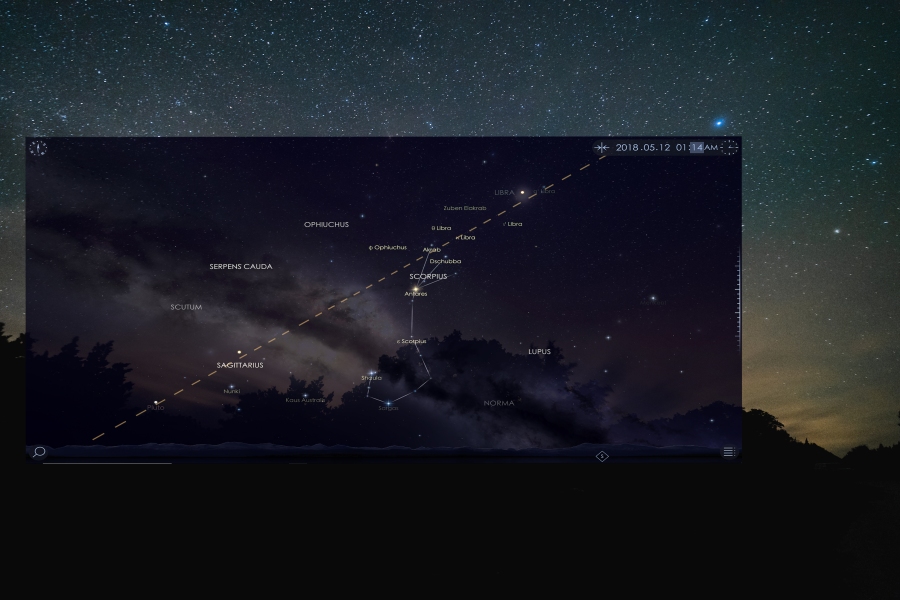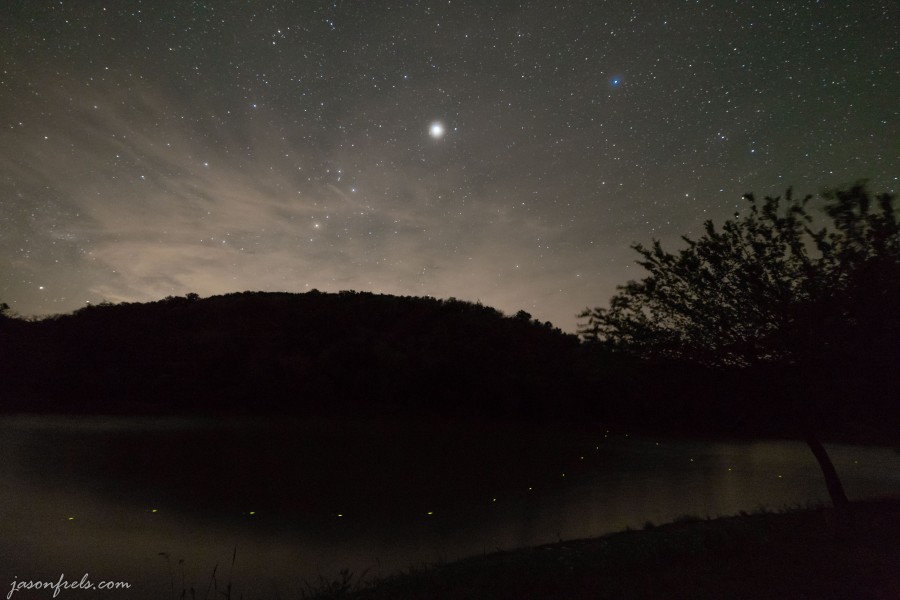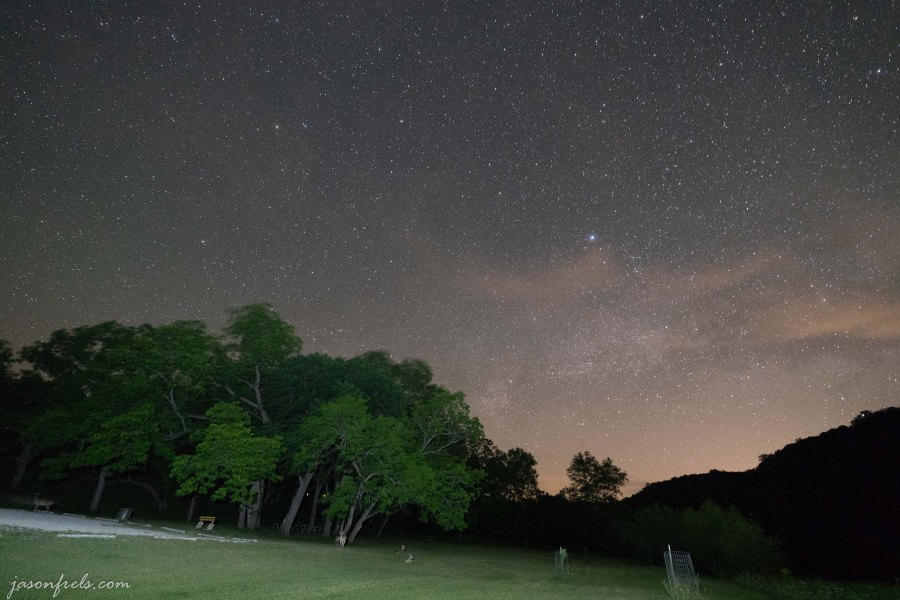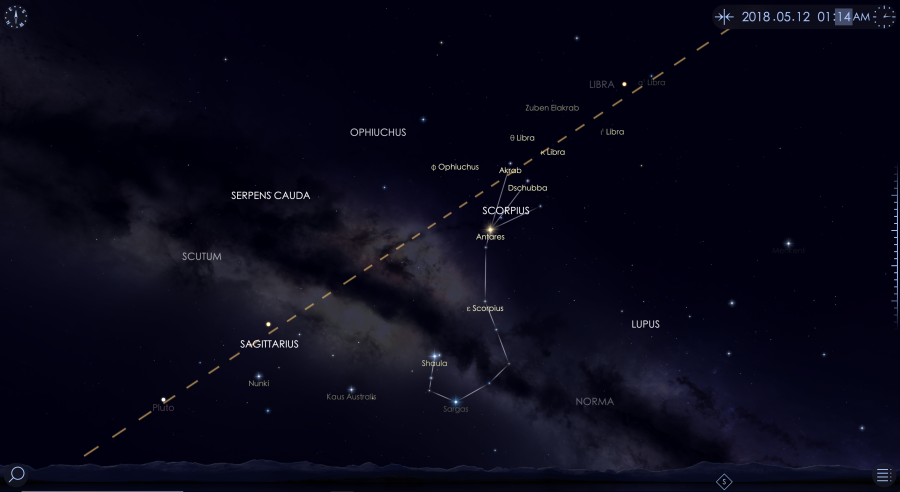I went out to Colorado Bend State Park Texas to attempt some night sky photos. There was no moon, the forecast called for clear skies, and Colorado Bend has some of the darkest night skies near me. So, I went out and waited until about midnight when the galactic core was to be up in the Southern sky. What I got was a clouds to the South that continued to build as the night went on.
The photo below is facing South. You can see part of the galactic core to the left, but mostly you see some distant clouds lit by a distant town. You can also see Jupiter very prominent and dominating the sky.
The above photo was taken with a Nikon D750 and a 14mm lens, at f/2.4, ISO3200, and 30s exposure. 14mm is a very wide lens and you can push the shutter time to 30s without getting stars running much. I recently purchased this Rokinon 14mm f/2.4 lens for just this purpose and have been waiting for a good opportunity to get some night sky pictures. Maybe next time.
Below, I superimposed an image from a night sky program I have. This shows where the galactic core was to be just above the horizon. I basically lined it up in Photoshop using the constellation of Scorpius. The galactic core was rising and rotating about the Southern horizon.
But as the galaxy rose, the clouds continued to move in and pick up light from distant towns. I do have pictures from this location on a clear night in which the sky is very dark. Jupiter was also incredibly bright in the night sky and dominating every picture.
I was briefly entertained by a firefly. In the picture below you can see trail of firefly light as it flew along the river.
I was also closely watched by some deer. I could see their eyes in the dark, so in one exposure I turned on my head lamp for a couple of seconds so that they would show up in the picture.
I use a couple of programs to plan out my attempted night-sky photoshoot. One is called Star Walk 2; it is a Window 10 app that you can get in the store. It allows you to find where the stars, planets, etc. will be in the sky at a particular location and time. You can enable constellations and asterisms, which I find interesting as well. Below is the screen capture I used to identify the stars in my photo and where the galactic core of the milky way is supposed to be.
Another thing I use is the PhotoPills app on my iPhone. This app allows you to plan out the time and location of rising and setting of the sun and moon, where the galactic core will be from any place on the map, times for civil, nautical, and astronomical twilight, and it has an augmented reality mode so that you can superimpose some this information over what the camera sees. I also use this app when planning to photograph in Austin before dawn.
I also use a website called DarkSiteFinder.com. This site shows a light pollution map and helps you find good places to stargaze or take night-sky photography. The map is here: http://darksitefinder.com/maps/world.html . It is very useful to plan out your expedition as this usually involves a long trip to get away from the anthroposphere and its light pollution which overwhelms much of the night sky. You can see that for the darkest skies in Texas, I would have to head out to the Big Bend area where few people live.
I will try again soon if I can find a time when the weather and moon are cooperating. Summer is the time to get the galactic core in a photo and I have a lot of fun doing this. Thanks for reading and leave a comment below.






Beautiful. I really want to get out to that park this summer. It must stay busy–any time I try to make camping reservations there, it’s already full.
LikeLiked by 1 person
Yeah, you either have to reserve a month in advance or go during the week.
LikeLiked by 1 person
Great pictures. It’s very interesting how the stars all have slightly different colours. Also how bright Jupiter is!
LikeLiked by 1 person
I was also amazed at Jupiter. It was so bright I could actually focus on it, which is a problem at night. Even though I focused it, it was still a bit smeared in the image. I guess because it was so bright against the background.
I have looked around at other recent Milky Way pictures from others, and they all have Jupiter very prominent as well. Saturn was probably visible but a bit behind the clouds on the horizon.
Thanks
LikeLike
Just fantastic. Great captures and amazing info .
LikeLiked by 1 person
Thanks for the feedback.
LikeLiked by 1 person